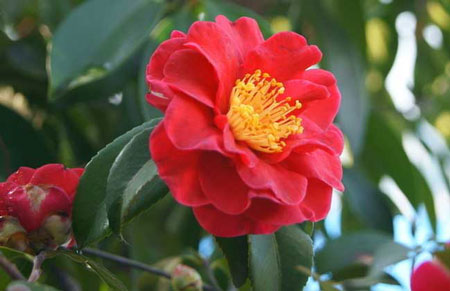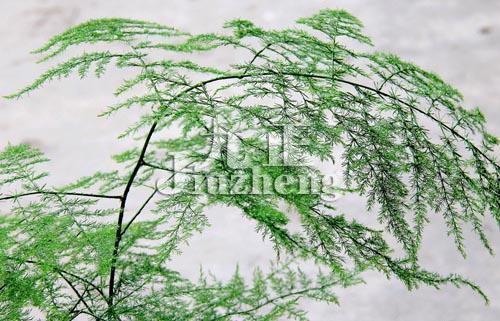Required environmental conditions and reproduction of camellia
Camellia is one of the top ten famous flowers in China, and it is also a famous ornamental tree species all over the world. Its leaves are evergreen, green and bright, the flowers are extremely gorgeous, and the flowers are dense like brocade, which can be described as a tree with ten thousand buds, beautiful and lovely. Camellia is native to the southern provinces of China and Japan. Sex likes warm and humid climate, grows well in the shade, is afraid of the hot sun in the north, is not hardy, and the overwintering room temperature should not be less than 6 ℃. The optimum temperature for growth was 15-25 ℃, and the growth stopped when the temperature was above 29 ℃.
Camellia is very strict with the soil and can only grow in acidic soil. If the soil is alkaline, the leaves will gradually yellowed and fall off, resulting in death. Camellia can be sown, cut, or propagated by pressing and grafting. Most of the varieties with strong double petal can not bear fruit after anthesis, so the seeds can not be collected. The seeds of single-petal varieties can be collected to cultivate rootstock seedlings for grafting of double-petal varieties.
After the seeds are ripe, it is best to sow along with the harvest. If spring sowing is carried out, the seeds should be stored in sand for a winter and sown from February to March the following year, and the seedlings will not emerge until more than 2 months after sowing. Cutting propagation requires pre-treatment of branches. In September, select the full-growing annual branches, cut off the lower leaves, each branch retained only the upper 3 leaves, and then choose the appropriate part to peel off a circle of cortex, the wound part will gradually grow a ring of tumor-like healing. In late January of the following year, the branches were cut off from the bottom of the healing body, wrapped in mud or peat, and then inserted into the moist Suhe soil to make it take root and sprout. This method has high survival rate and fast rooting.
In the case of small reproduction, the high branch pressing method is mostly used. The high branches were pressed in late September, cut off from the mother from April to May the following year, and 5-10 trees were planted in a large flowerpot and maintained in the shade. After a year of growth, the seedlings were divided into pots in March of the next year. As long as they were carefully nurtured, they could bloom before the Spring Festival. Grafting has branches and buds, usually with Camellia oleifera or single camellia as rootstock.
Branch grafting is carried out from May to July, generally cut off at about 5 cm from the ground, split about 1.5 cm in the center of the rootstock, scion length 3 cm 5 cm, with 1 leaf, the lower part is cut into a wedge, inserted into the rootstock incision, the cambium is tied up, and then moisturized on the outside with a plastic bag cover, the lower mouth should not be tied too tightly. For some precious varieties which are not easy to take root, the grafting method is mostly used, usually from May to June. After about 3 months of grafting, after the interface has healed firmly, the scion should be cut off from the base of the interface and detached from the mother; at the same time, the rootstock should also be cut from the upper end of the interface to make it a new plant.
Required environmental conditions and reproduction of camellia
Camellia is one of the most famous indecent flower trees in China and Taifu. Especially the leaves are evergreen, the emerald green is bright, the flowers are extremely beautiful, and the flowers are dense like brocade, it can be said that the trees are ten thousand buds, beautiful and beautiful. Camellia originates from the southern provinces of China and Japan. Sexual preference for warm and humid weather, outstanding development in the shade, fear of the northern sun exposure, also not cold-resistant, overwintering room temperature should not be less than 6 degrees. The suitable temperature for development is 15-25 degrees, and the development is restrained when the temperature is above 29 degrees. Camellia is very strict on the soil, only in the acid soil can develop, if the soil is alkaline, the leaves will gradually yellowing and falling off, resulting in extinction.
Camellia can be sown, cut, or bred by pressing and grafting. Most of the double petal petals are not strong after flowering, so the seeds can not be picked. The seeds of single-petal varieties can be collected to cultivate rootstock seedlings for grafting of double-petal varieties. After the seeds are ripe, it is best to sow along with the harvest. If sowing in spring, the seeds should be stored in sand-winter, sown in February to March, and seedlings can emerge more than 2 months after sowing.
Cuttings need to be disposed of in advance to breed. In September, the fully developed branches of the same year were selected, the lower leaves were cut off, and only 3 leaves were preserved in each branch, and then the appropriate part of the □ was cut off, and the injured part of the plant gradually grew into a nodular callus. In the last ten days of January, the branches were cut off from the bottom of the healing body, and the shearing □ and the healing body were wrapped in mountain mud or peat, and then inserted into the moist Suhe sand to make it take root and sprout. The survival rate of this hair is high and the hair root is fast.
In the environment where the breeding amount is not large, the high branch pressing method is often adopted. The high branch pressing was carried out in late September, the mother was cut off from April to May, and the 5~lO was planted in a large flowerpot and maintained in the shade. After a year of development, the seedlings were divided into pots in March. As long as they were carefully cultivated, they could blossom before the Spring Festival. Required environmental conditions and reproduction of camellia
Camellia is one of the top ten famous trees in China, and it is also a famous flowering tree species in the world. Especially evergreen leaves, bright green, extremely gorgeous flowers, and flowers dense like brocade, can be described as a tree ten thousand buds, beautiful and lovely. Camellia originates from the southern provinces of China and Japan. The sex likes the warm and humid climate, grows well in the shade, is afraid of the hot sun exposure in the north, is not resistant to cold, and the overwintering room temperature should not be less than 6 degrees. The suitable temperature for growth is 15-25 degrees, and usually stops growing when it is above 29 degrees. Camellia is very strict with the soil and can only grow in acidic soil. If the soil is alkaline, the leaves will gradually yellowed and fall off, resulting in death.
Camellia can be sown, cut, or propagated by pressing and grafting. Most of the varieties with strong double petal can not bear fruit after anthesis, so the seeds can not be collected. The seeds of single-petal varieties can be collected to cultivate rootstock seedlings for grafting of double-petal varieties. After the seeds are ripe, it is best to sow along with the harvest. If spring sowing is carried out, the seeds should be stored in sand for a winter and sown from February to March in the second year, and seedlings will not emerge until more than 2 months after sowing.
Cutting propagation requires pre-treatment of branches. In September, select the full-growing annual branches, cut off the lower leaves, each branch has only 3 leaves, and then select the appropriate part to cut off a circle of cortex, the wound part will gradually grow a ring of tumor-like healing. In late January of the following year, the branches were cut off from the bottom of the healing body, wrapped in mud or peat, and then inserted into the moist Suhe sand to make it take root and sprout. The survival rate of this hair is high and the hair root is fast.
In the case of small reproduction, the high branch pressing method is mostly used. High branch pressing was carried out in late September, and from April to May of the following year, 10 trees were cut off from the mother, planted in a large flowerpot and maintained in the shade. After one year of growth, the seedlings were divided into pots in March of the second year. As long as they were carefully nurtured, they could bloom before the Spring Festival.
Grafting has branches and buds, usually with camellia oil or single camellia as rootstock. The branch grafting is carried out from May to July, and the cutting is generally cut off at about 5 cm from the ground, with a depth of about 1.5 cm in the center of the rootstock, with a scion length of 3 cm and 5 cm, with 1 leaf and 2 leaves, cut into the lower part of the rootstock, and inserted into the incision of the rootstock. After binding the cambium, and then moisturizing the outside with a plastic bag cover, the lower mouth should not be tied too tightly. For some precious varieties which are not easy to take root, the grafting method is mostly used, usually from May to June. After about 3 months of grafting, after the interface has healed firmly, the scion should be cut off from the base of the interface, the moose mother; at the same time, the rootstock should also be cut off from the upper end of the interface to make it a new plant.
- Prev

How do camellias propagate?
Camellia is often propagated by cutting, and can also be propagated by pressing and grafting. The main results are as follows: (1) the method of cutting is the most suitable from April to July. Select the annual, sturdy, pest-free twigs as cuttings, the cuttings are about 10 cm long, with 1 top bud, 1 lateral bud, 2-3 leaves, and all the lower leaves are removed.
- Next

How does asparagus reproduce?
There are two kinds of propagation of asparagus: sowing method and split method, but the plant shape of the plant is often incorrect, so it is not used much, and most of them use sowing method. However, it is not as easy as ordinary herbs to make asparagus seed. Potted asparagus usually blossoms after 4 or 5 years. If it is mismanaged, it will not bear fruit even though it blossoms.
Related
- Fuxing push coffee new agricultural production and marketing class: lack of small-scale processing plants
- Jujube rice field leisure farm deep ploughing Yilan for five years to create a space for organic food and play
- Nongyu Farm-A trial of organic papaya for brave women with advanced technology
- Four points for attention in the prevention and control of diseases and insect pests of edible fungi
- How to add nutrient solution to Edible Fungi
- Is there any good way to control edible fungus mites?
- Open Inoculation Technology of Edible Fungi
- Is there any clever way to use fertilizer for edible fungus in winter?
- What agents are used to kill the pathogens of edible fungi in the mushroom shed?
- Rapid drying of Edible Fungi

